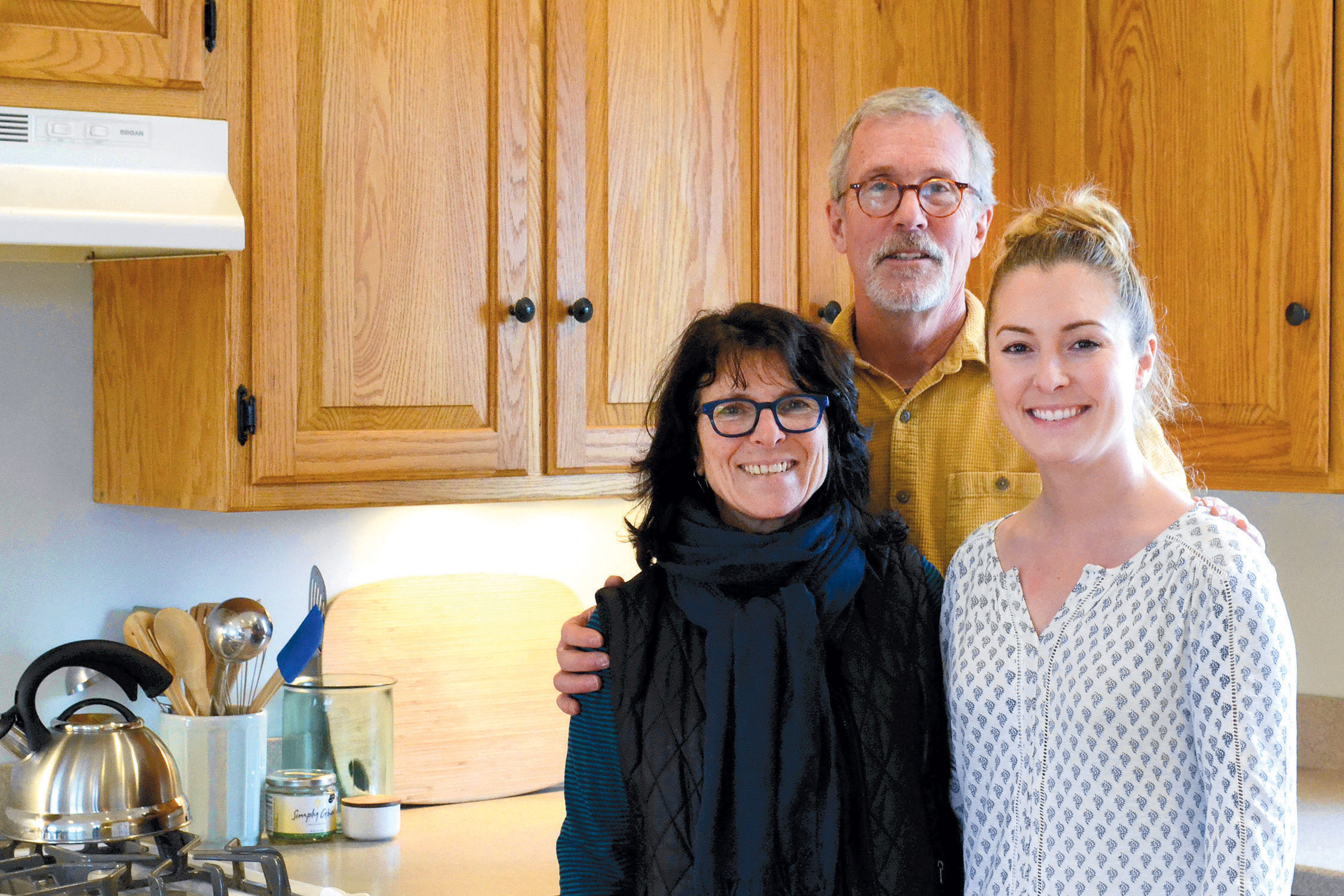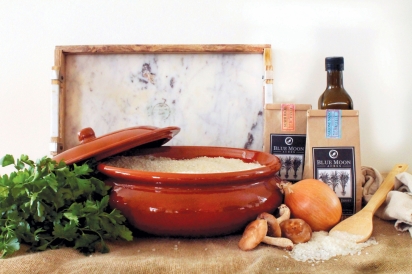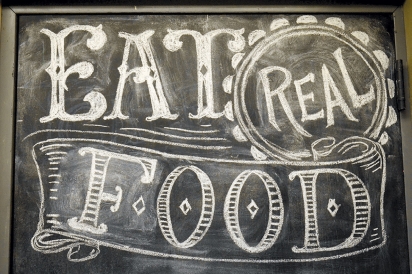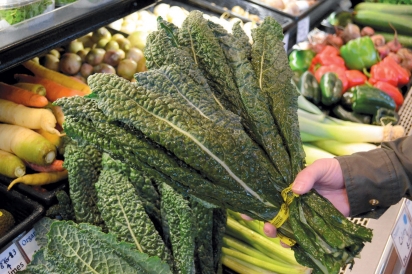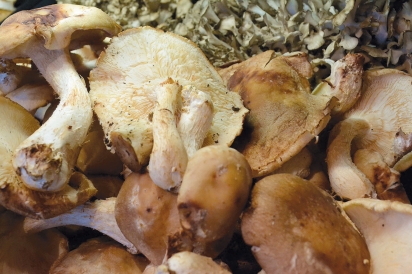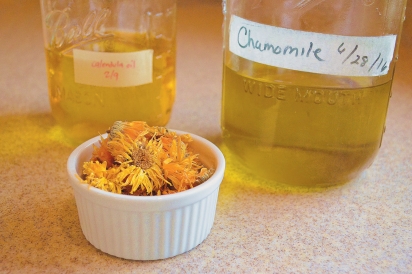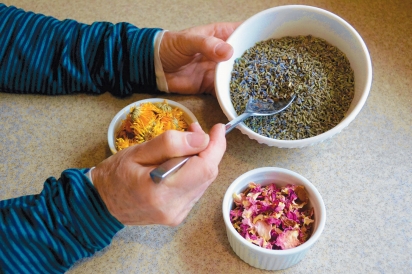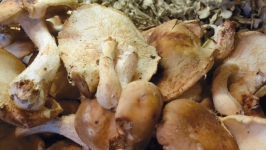In the Kitchen: Local Eating with Blue Moon Acres
Growing up, Ashley Lyons Putman’s lunchbox wasn’t quite like the other kids. When you’re the daughter of organic farmers Jim and Kathy Lyons of Blue Moon Acres, Lunchables don’t make the cut. “So I’d take out this big, black orb,” Ashley says with a laugh. Brown rice balls filled with pickled plum paste were common.
While she fared poorly in lunchroom trades, Putman learned about healthy food early on. That made her and her brothers adventurous and mindful eaters. It was perfect preparation for her work as the farm’s director of sales and marketing today.
“When I turned 13 or 14, I wanted to eat sugar,” she recalls. “So I went out, ate it, and felt awful. I made the connection with what my mom and dad were telling me: you’re going to feel the food.”
Lest this seem a hardship, the Lyons family eats very well, with a focus on unprocessed ingredients and simple meals. The challenge, as for all farmers, comes in finding the time for cooking when seasonal demands result in long weeks. Luckily, the Buckingham, PA, natives had the foresight to build a farmhouse kitchen and apartment right at their Pennington farm.
Blue Moon Acres is split between two properties. At their original farm in PA, they grow more than 40 kinds of microgreens, revered by chefs. In Pennington, the focus is on field production—63 acres of it—including Jersey-grown rice (which Edible Jersey first covered in winter 2015).
This is large-scale, sustainable production, driven by conviction— and it’s having an impact. When the Lyons opened in Pennington, the soil’s organic matter (a measure of soil health) was about 1 percent. Now it’s as high as 10 percent. This year, Blue Moon Acres will transition to no-till farming, which prevents erosion, conserves water in the soil and builds soil structure.
It’s the logical next step in an adventure in healthy eating that started 25 years back.
Tell me about the farm’s origins.
KL: We started as a CSA in Buckingham, PA. Then we quickly realized that we didn’t have enough land there to support our family. So the second year, we thought the best use of the land would be to grow more intensively, with greenhouses. We started with microgreens [selling to] one account in New York. That was 1992 at the New York Yacht Club.
JL: The chef there was very well connected. That gave us our start. What led you down the organic path?
What led you down the organic path?
KL: The joke is that my parents were farmers and were always trying to get me to farm. I hated it. Then, of course, I meet Jim, and all he ever wanted to do was farm.
JL: We met in Boston, where we were both studying macrobiotics. How does that influence your mission?
How does that influence your mission?
JL: It’s looking at food as energy. In macrobiotics, you want to eat food that’s a little more centered, energy wise. On one extreme you have sugar. On the other extreme you have salt. Then you have grains, beans and vegetables in the center. The concept is to eat less refined, to eat locally so you’re in balance with nature.
How did that sentiment translate at the family table?
KL: The more simply you eat, the more aware you become of the effects of food. If you’re eating sugar and alcohol and red meat, you become desensitized. When you eat more in the center, you notice the effect. Our kids were raised without any milk. No dairy. No sugar. We did no processed food. We still use that as the basis of our diet, but we’ve widened it out. So we eat organic chicken and fish. A couple times a year, I’ll eat a grass-fed burger.
JL: So if we’re not eating that much animal food, what are we eating? We’re eating good grain. I love eating rice. I could eat it every day, or at least every other day. Can we grow rice in a sustainable fashion? That’s what we’re working on. So much of what we have now in terms of health problems comes down to what we’re doing here. It comes back to the soil, to the difference in the amount of nutrients in a piece of organic kale grown in really healthy soil versus a conventional kale.
Back in the day, we would buy kale from a company called Cal- Organic. We would steam up a pot of it, and it would be sitting there waiting for the rest of the meal to finish cooking. If it was Cal-Organic, it would be gone before the meal even started. The kids would pick at it until it was gone. If it was conventionally grown, it wasn’t sweet, it wasn’t delicious, and they would leave it. That’s one of the reasons we’re switching to no till. Tillage really damages the microbiology of the soil.
What else do farmers know that would benefit home cooks?
KL: The more we remember seasonality, the healthier we will be. To live where we live and be drinking orange juice every morning doesn’t make sense. If you live in a very hot area, where oranges grow, then you’re in alignment with that fruit. In the northeast, our bodies would do better if we were eating more root vegetables, green leafy vegetables and grains, and some meat.
How do your personal roots influence your cooking?
KL: My parents were peasant farmers from Italy. My mother and father met on the farm. There was never any consideration to just eat a pork chop. You used the whole animal. In my Italian background, food was paramount. They ate very simply, and there were no processed foods. My mother made pasta twice a week, and everything was from scratch. She preserved for the winter. They definitely had the instinct of eating whole foods.
JL: My parents were both Irish, and my mother was a good cook. She wouldn’t allow junk food: very little sugar, no potato chips. The only time it was in the house is when my father would have his buddies over to play bridge and we would immediately dive on it. My mother was very good about that, and she would cook every night. But it was meat and potatoes.
Do you cook together as a family?
KL: We do cook together. We have a lot of traditions around food. Brown rice is a staple. I still make pasta. My favorite is made with 100 percent spelt flour. I cut into soup noodles and serve them in a broth with spinach, garlic and olive oil. Or I serve it in garlic and white-wine sauce with broccoli rabe.
JL: It dissolves in your mouth. The first time I had one of these spelt noodles of Kathy’s, it was like, “Wow.” Kathy grew up with a very hands-on, very salt-of-the-earth approach. Her mother had a garden. She would make pasta two times a week, draped over furniture on sheets. There is also another famous dish in our house. It’s called “Dad’s Dashi.” When Kathy wants to take a break from cooking, or everyone is too tired to cook, I’ll jump in and make it. It’s a wonderful broth.
ALP: It’s healthy comfort food. As a kid, that was fun to eat, because there are all of these textures and flavors. The first time I made it for my husband, he loved it. And the crazy thing is that dashi, way back when—file it in the category of the rice ball. That is what chefs are making now. It’s amazing. Where were all of these people then?
What are your pantry staples?
KL: We have two main ethnic influences: Japanese and Italian. So there is olive oil and garlic, always. We use olive oil from Stockton Market, which is Tunisian.
JL: We also use a lot of ginger. Toasted sesame oil. And plum paste: umeboshi. There are some dishes from that macrobiotic era utilizing foods that are incredibly healing, like umeboshi and kudzu. Kudzu is an amazing crop and very soothing.
ALP: Umeboshi is always on the table when we have our sweet corn. You can also put the kudzu in a tea with umeboshi and grated ginger. You use kukicha, which is a twig tea, and that’s what we drank when we had stomach ailments as kids. Plus nori sheets as a snack. We’d come home and kill a whole bag of those. We also used our pressure cooker all of the time to cook rice when growing up.
How gratifying is it to eat your own rice?
JL: The black rice is ridiculously fragrant. It just fills the kitchen. My go-to is a pot of brown rice. We also have wonderful Italian rice, which we use to make risotto.
ALP: This past Christmas, my Dad made a big ceramic risotto potful. When we took a trip to Italy one year, the risotto was served tableside in one of these huge vats. There’s all of the pomp and circumstance there, and it’s great. Sure enough we found one in Stockton Market, where we have a stand.
JL: You put it right on the stove. It’s wonderful.
Overall, your family’s culinary approach hinges on mindfulness, it seems.
JL: The reason you’re craving one food or another is your body telling you what it wants. In Boston, our teacher one day came into class and asked, “Are you choosing the food that you are eating, or is the food choosing you?” At the end, he said it was the latter. It’s like Michael Pollan’s Botany of Desire, where he says that corn is using us to take over the world. As Westerners, we think with our egos. I think what you come away from macrobiotics with is that we potentially have it backwards. Through farming, you realize that everything is really connected.
What do you recommend to those who want to eat more thoughtfully?
KL: Do it gradually. I was overnight, and it was hard.
JL: Start to include good-quality whole grain, like whole-grain sourdough bread—something that’s more digestible.
KL: And vegetables. In general, people have lost their taste for simply-cooked vegetables, so they douse them in sauce or butter, or stir-fry them in oil.
ALP: People would be surprised at their ability to strike that balance. There’s that intuition; it’s just covered up. You change your cravings via what you’re eating, if you’re disciplined enough, and those things can be delicious. It pays you back.
Blue Moon Acres Market
11 Willow Creek Drive, Pennington
609.737.8333
Also on site at the Stockton Market, Friday - Sunday
MEDICINAL HERBS WITH KATHY
In addition to serving as the family’s farm kitchen, Blue Moon Acres’ herbal products are made in Pennington. The scent of dried herbs is heavenly.
Was this a long-time dream?
KL: My passion is herbs.We have edible flower gardens and a culinary herb garden. It started in Buckingham, and we’ve been growing for three years here.
Do you cook with them?
KL: Sometimes I use the lavender for smoothies and for infusing whipped cream. I make candied violas and rose petals.
What are your favorites?
KL: Calendula—it’s so healing.You can use it in tea and as a dye. My second favorite is arnica. It’s really good for any kind of inflammation. I also do a mask or cleanser using our rice hulls and rose petals with clay, essential oils and vitamin E. Sometimes I’ll just leave it on.And then I spray with our rose water and glycerin spray.


